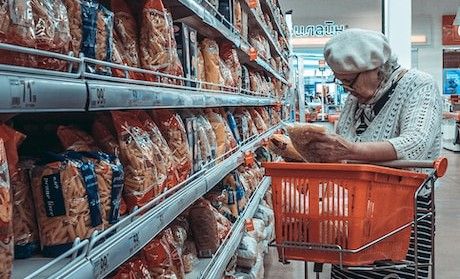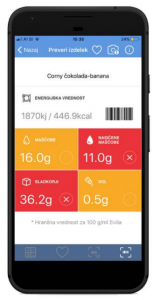Branded food databases, food labelling, and reformulation

Branded foods databases are becoming very valuable not only in nutrition research but also for clinical practice, policymakers, businesses, and the general population. This because the percentage of branded foods that consumers purchase compared to generic foods is steadily increasing. In contrast to generic foods, branded foods are marked by rapid changes because of reformulations, the introduction of new foods, and the removal of existing ones from the market. Reliable data about the composition of branded foods is essential to provide insights into those changes.
Explore different methods to generate branded food datasets, examples of available tools and services for who wants to use such datasets, and a series of case studies developed in the FNS-Cloud project for the different types of users of branded food datasets.
What are branded foods?
Branded foods are prepacked foods, typically equipped with a label showing information on the ingredients and the nutritional content. Barcodes are usually used as a unique identifier of specific foods.

What are branded food datasets?
Branded food datasets are very large datasets with nutrient composition and other information for tens of thousands prepacked foods. Data usually reflect information from food labels, and could be enriched with additional information. Datasets need to be updated regularly because new or reformulated foods are being launched all of time while other products are removed from the market.
Why do we need branded food datasets?
Food researchers need food label data to support food policy development. For instance, they monitor food and nutrient intake, and progress on food reformulation. Food label data is also very useful for dietitians, public health educators, mobile app developers and the food industry.
How are branded food datasets generated?
Food label information can be sourced from food manufacturers and retailers, from physical food labels, or from web pages with labelling data of branded foods (i.e. online food stores, manufacturer’s web pages, etc.). In the FNS-Cloud project, we used and compared various approaches to generate a harmonised branded food dataset, which was used for a series of demonstration case studies.
Data from food manufacturers and retailers
Food businesses voluntarily share data about their products in some countries. For example, the Dutch LEDA (LevensmiddelenDataBank) database is updated daily with information about newly launched and reformulated foods. The database contains tens of thousands food items and covers the majority of the foods sold in Dutch supermarkets. Data are compiled through collaborations with data providers, which are either intermediate companies such as GS1 and Brandbank or supermarket chains or individual supermarkets.
More information: Westenbrink et al. 2021. J Food Comp Anal. Doi:10.1016/j.jfca.2021.104044
Data from food labels
Food monitoring studies present a standardised approach to generate representative branded food datasets. To ensure datasets are nationally representative, foods must be selected from core retailers. A variety of grocery stores must be included, from discounters to hypermarkets. The best approach is to collect as many types of food products as possible. This is why food monitoring studies include tens of thousands of foods. Food monitoring studies are conducted regularly in some countries. In Slovenia for example, tens of thousands of foods are monitored regularly using the CLAS tool, which simplifies data collection and analyses.
More information: Pravst et al. 2021, Front. Nutr. Doi: 10.3389/fnut.2021.798576
Data from internet
Web-scrapping of internet pages can be used to generate large branded food datasets. For example web-scraping of online grocery stores was used in Canada to generate a large database with more than 50.000 unique products. A similar approach is used in other countries. Such an approach enables efficient collection of data particularly for market-leading foods, but might miss some niche products that are not available in online stores.
More information: Ahmed et al. 2022. Front. Nutr. 8:825050. Doi: 10.3389/fnut.2021.825050
Data from citizens
Crowdsourcing can also be used to provide food labelling data. For example, in the FNS-Cloud project, the free mobile phone app VesKajJeš (“You know what you eat”) was used to collect food labelling pictures of thousands of food products available in Slovenia, enabling the development of a large branded foods dataset. Comparison with standard food monitoring approach showed that crowdsourcing is particularly useful for updating branded food datasets with data about newly launched and reformulated foods.
More information: Pravst et al. 2021, Front. Nutr. Doi: 10.3389/fnut.2021.798576
Learn more about Food Monitoring Studies in this video.
Services and tools for branded food datasets
This section details examples of available resources for users of branded food datasets that were used or generated in the FNS-Cloud project.
JSI Food Matching Web Services
A variety of automatic services have been developed within FNS-Cloud by Jozef Stefan Institute (JSI), enabling automatic parsing of ingredient lists, which are provided on food labels in semi-structured text format. This service enables parsing of single text strings into separate descriptor and ingredients (also when string consists of several complex embedded ingredients) and extraction of the provided content of the ingredient. This service also enables matching of ingredients with large food composition databases, providing further details about the nutritional composition of the product.
Verified By GS1
The tool “Verified by GS1” provides details about product identity based on the Global Trade Item Number (GTIN), which can be found on food labels in the form of a barcode. This is a cross-industry global initiative, launched with the support of major multinational companies. This tool enables access to seven core product attributes, provided by brand owners: GTIN, brand name, product description, product image URL, global product classification code, net content & unit of measure, country of sale.
Composition and Labelling Information System (CLAS)
The CLAS tool was developed by the Slovenian Nutrition Institute for efficient conduction of food monitoring studies and generation of branded food datasets. It is nowadays used by research and governmental organisations in different countries.
CLAS comprises a mobile application and web platform. The mobile application simplifies the collection of food packaging photographs in food stores. Barcodes are used to avoid duplicate records, even if the study is conducted in different stores at the same time.
The CLAS web platform supports efficient and systematic data extraction, and data processing. Monitoring can include all types of foods, including food supplements. Collection of data is automated with the help of optical character recognition to extract text from photographs. Tailored functionalities are available for different types of data on labels, with particular emphasis on nutrient composition and ingredients, which includes food additives, vitamins and minerals, and allergens. Other functionalities enable collection of data about nutrient profiling and the use of symbols or other marketing strategies, such as nutrition and health claims or marketing aimed at children.
FNS-Cloud harmonised branded food dataset
The FNS Cloud branded food dataset was compiled by merging and harmonisasing different datasets, compiled in four countries with different methodologies, to enable conduction of case studies within the FNS-Cloud project. Datasets include mandatory food labelling information about nutrition composition of foods/drinks within three categories, that are important for reformulation strategies: soft drinks, breakfast cereals and yoghurts. Dutch (NL) data originate from the Dutch Branded Food Database LEDA, which is compiled through collaborations with data providers (supermarket chains, individual supermarkets, or intermediate companies such as GS1 and Brandbank,). Swiss (CH) data originate from the Swiss food composition database V5.3, in which branded foods data were mainly received from Swiss own-brand retailers Migros and Coop. German (DE) data were downloaded from the open access Open food facts crowdsourcing platform, a collaborative project with contributors from all around the world. Slovenian (SI) datawere collected within the FNS-Cloud food monitoring study, using the CLAS tool. It should be noted that some datasets collected outside FNS-Cloud are subject to access restrictions.
Users of branded food datasets
The aim of the “food labelling & reformulation” demonstrator is to showcase how food label data and branded food databases can be useful to a wide range of users, from researchers to policy makers, consumers, food businesses, app developers and clinical practitionners. The cases studies below illustrate differents aspects of the use of food labelling data.
Researchers
- epidemiological dietary studies (consumption)
- dietary intervention studies
- clinical intervention trials, where diet or foods are considered co-founding factors
- food supply studies assessment of exposure to food components
Assessing the validity of data in branded food datasets
Valid food composition data are needed in nutrition research, for example in studies investigating dietary intakes, where branded food datasets are becoming a particularly valuable resource. However, the question arises whether food labelling data correspond to the actual composition of the branded foods. A case study was conducted on 51 sugar-sweetened beverages in the CLAS branded food dataset, in which labelled content of sugar was verified by laboratory measurements. The study results showed that the labelled sugar content is reliable and can be used to compile branded food databases. The sugar content was within the tolerance levels in all investigated samples.
More information: Hafner et al. 2022, Front. Nutr. Doi: 10.3389/fnut.2022.794468
Policy Makers
- basis for evidence-based food policy decisions monitoring of the food supply
- assessment of efficacy of food reformulation programmes
- regulatory restrictions, related with specific food components (trans fats, additives…)
Monitoring food reformulation
Continuous food monitoring studies provide insights about the changes in the food supply, supporting the decisions of policy makers. Such monitoring can be focused on various aspects of food composition, including the content of nutrients and the use of food additives. The FNS-Cloud project used longitudinal data, originating from several cross-sectional food monitoring studies, to provide insights on food reformulation. An example of such study, which was focused on both nutritional composition and use of additives, exploited trends in the composition of non-alcoholic beverages in Slovenia. The study highlighted a sharp rise in the use of sweeteners between 2017 and 2020.
More information: Hafner et al. 2021, Front. Nutr. Doi: 10.3389/fnut.2021.778178
App Developers
- operation of IT services where branded food composition data is needed
- mobile apps and web services for supporting consumers and health practitioners (to support dietary, lifestyle and health objectives)
Consumers
- supporting and guiding informed food choices
- enabling comparison of different foods
- supporting choices of healthier foods
- assuring food safety, particularly to those with special dietary needs (including allergen management and specific diets)
Branded food datasets are a useful resource for app developers and support healthier food choices
 Access to reliable branded food datasets is essential for efficient functioning of mobile apps that are covering peoples diets and food choices. In the FNS-Cloud project, we used automatic data transfer through an Application Programming Interface (API) to connect the data collected in the food monitoring study with the mobile app VešKajJeš, which is used in Slovenia to support consumers in healthier food choices. Transferred data included all parameters needed for nutrient profiling in the food traffic light system (food category, the content of sugar, salt, (saturated) fat) and energy value.
Access to reliable branded food datasets is essential for efficient functioning of mobile apps that are covering peoples diets and food choices. In the FNS-Cloud project, we used automatic data transfer through an Application Programming Interface (API) to connect the data collected in the food monitoring study with the mobile app VešKajJeš, which is used in Slovenia to support consumers in healthier food choices. Transferred data included all parameters needed for nutrient profiling in the food traffic light system (food category, the content of sugar, salt, (saturated) fat) and energy value.
More information: Pravst et al. 2021, Front. Nutr. Doi: 10.3389/fnut.2021.798576
Food businesses
- identification of opportunities for improving composition of foods (development of new foods, reformulation)
- comparisons with other foods – use of comparative nutrition claims
Clinical practitionners
- nutritional counselling in patients (evaluation of intakes of foods/nutrients)
- preparation of diets for patients with special dietary needs (including allergies) or medical conditions (for example diabetes)
